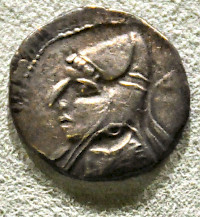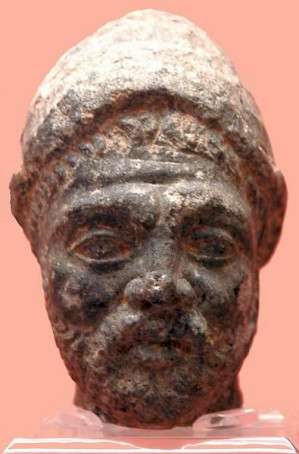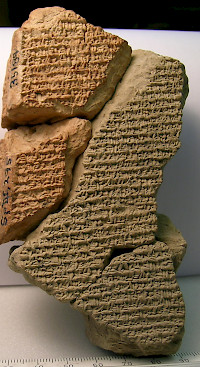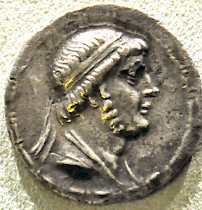Bagayasha
Bagayasha or Bacacis: Arsacid prince, mentioned in several sources in the years 138-120 BCE. He is almost certainly identical to the Bagasis who briefly reigned as king in 127/126.
Reign of Mithradates

Bagayasha, a brother of an Arsacid king, is named a few times in the cuneiform sources. G.R.F. Assar has argued convincingly that this Bagayasha was none other than the Bacasis who, according to Justin, was appointed praefectus of Media by the Parthian king Mithradates I the Great. Assar also maintains that this Bacasis was Mithradates’ brother.note
According to the traditional dating, Mithradates reigned from ca. 171-139/8 BCE. He was the real founder of the Parthian Empire. Setting out from Parthia and Hyrcania on the southeast of the Caspian Sea, Mithradates conquered Media in 148 BCE and appointed Bacasis as governor.note In the first two months of the Babylonian year SEB 171, i.e. between 13 April and 10 June 141 BCE, Mithradates conquered Babylonia.note
He now accepted the title of Great King.note He also took the surname Philhellene, in spite of his wars against the Seleucids. Apparently he wanted to appease his new Greek subjects who lived in cities like Seleucia on the Tigris, Babylon, Susa and elsewhere. In July 141, he captured Seleucia and in October he reached Uruk in southern Babylonia.
In the summer of 138 BCE, the Seleucid king Demetrius II Nicator tried to reconquer Babylonia, but without success. He was beaten, taken prisoner, and kept as hostage at the Parthian court. He was well-treated and got Mithradates’ daughter Rhodogyne as wife.note
Astronomical Diaries

This is the context of four references to Bagayasha in the cuneiform record. The first of these is an Astronomical Diarynote relating the fact that a Parthian army entered Babylon on 5.II.174 SE = 13 May 138 BCE. The broken context makes further mention of the fact that in the same month Bagayasha
who [had gone] to the cities of the province of Assyria (=Mesopotamia) ... had mustered his army and had departed to the cities of Media.
The same diary reports on the reverse that two months later king Arsaces (= Mithradates I the Great) departed from Media to do battle with the Seleucid king Demetrius II Nicator,note who was approaching from the northwest. As indicated above, Mithradates defeated the Seleucid attacker.
The second report concerns month VII of year 177 SE = 1-30 October 135 BCE. It is told that on the 20th of the month, letters of a certain Menophilus were sent, which apparently disclosed the news that the king had suffered a serious illness. Perhaps it was an aggravation of a stroke (mišittu) the king had suffered in October/November 137 BCE.note Three days, later new letters arrived about the appointment of Bagayasha as substitute of the king. The letter was directed to the politai of Babylon and perhaps read out loud in the theater.note
The third reference to Bagayasha is in the diary concerning religious riots in Babylon and Borsippa in month VII 179 SE = 9 October – 6 November 133 BCE.note In that month Philinus, the general of Babylonia, who had been summoned in month I (April/May 133 BCE) to Media to “Bagayasha, the brother of the king,” was discharged from his office. On the 24th of the month (1 November) letters of king Arsaces were read out loud to the politai that a certain Theodosius had been appointed as the new general (strategos).
The last time we hear about Bagayasha is AD III p. 312, no. –119 concerning month II 192 SE = 20 May – 17 June 120 BCE. Letters were sent to the governor (pāhatu = epistates) and the politai of Babylon, and mention is made (in the letter?) about a certain [PN x]x-na-a, the son of Bagayasha “who was in charge of the four generals”, which means that he was “general of Babylonia who was in charge of the four generals”, perhaps as successor to Theodosius, and a certain Urrahšu, one of the (lower) generals.
A Chronographic Document

A recently discovered text, known as the Chronographic Document concerning Bagayasha (BCHP 18), describes a punitive action against the city of Babylon led by Bagayasha. It still awaits publication but may or may not refer to the third or fourth of the incidents mentioned above. The following appears to be reasonably clear:
- B1'-11': Bagayasha arrives in Babylon for a punitive action and asks account of the peliganes (council of elders). The generals are present, mention is made of plundering, politai, and “people who live in the palace” (perhaps people had fled into the palace or are captured in the palace). People leave their houses. It must have been a gruesome situation.
- 12'-18': Mourning and supplications. Babylonians, people of the land, women, the šatammu of Esagila, slaves of the king, a few politai, the governor (pāhatu = epistates) wear mourning. The people who are in the palace raise a cry of distress. It seems as if they have acted treacherously, but have changed their intentions, and are now set free. Perhaps their request is that the plundering soldiers go back to their garrison.
- 18'-25': PN-xx-nu, possibly the son of Bagayasha and maybe a military commander, intercedes. Many offerings and valuables are presented. Joy of heart in the land. PN-xx-nu leaves to his camp.
- 26': The šatammu with five Babylonians and the pahatu are summoned. PN-xx-nu returns; politai are brought back.
- 26'- 27': The general (= PN-xx-nu?) makes Parthian troops enter the garrison. Twenty brought-in people are deported and he takes the road to the city of Sha-pi-Adad.
- 27'-28': DAY 10: The general (strategos) of Babylonia assembles the Parthian troops of the garrison. At the command of Bagayasha they go out. The people of the land and the people who live in the palace leave for an unidentified place.
- 29'-31': DAY 11: Bagayasha enters Borsippa. The šatammu of Ezida provides offering animals and makes offerings for Nabû and Nanaia. Some decision is taken as regards the silver of the temple of the gods of Sha-pi-Adad. The prince leaves Borsippa.
- 33'-end: PN-Nabium (??) arrives. Long report about fighting. Conquest of “that city” (Sha-pi-Adad?).
It is hard to understand what has going on over here, but it seems that Babylon has acted treacherously, is looted, but ultimately pardoned.
Mithradates' Death
According to the accepted chronology, Mithradates died soon afterwards on his death bed in 138/7 BCE.note and was succeeded by his minor son Phraates II. This date, however, must be questioned on the basis of new cuneiform evidence.
G.R.F. Assar has made a good case for the theory that Mithradates did not die at all in 138 BCE, but that he continued to live until the very end of SEB 179 = 133/2 BCE. Support of this theory is found in Justin’s statement that Mithradates
succumbed to illness and died with glory at an advanced age, as great a man as his great-grandfather Arsaces.note

Mithradates’ illness seems indeed reported in the above mentioned diary concerning October 135 BCE and the appointment of Bagayasha as substitute king.note The king may have suffered a stroke earlier already in month VIII 175 SE = Oct/Nov. 137 BCE.note In official matters Mithradates remained king, letters were written in his name as the letter read in Babylon on 1 November 133 BCE, but decisions are made by the brother of the king.
According to Assar, the last cuneiform document dated to the old king is a hitherto unpublished astrological omen text,note Assar has suggestednote that the partial date-formula on the upper edge of Diary -132D1note reading: “[... Year] 179, King Arsaces,” is probably the latest record from the reign of Mithradates I.
The first tablet dated to the new king Phraates II, who probably was a minor and who had his mother as regent, is dated to month V 180 SE (31 July – 28 August 132 BCE).note
King
Although Justin, our most important source for the first century of the Parthian Empire, mentions that Phraates II was succeeded in 127 BCE by his uncle Artabanus I,note there is sufficient numismatic and documentary evidence (e.g, ostraca from Nisa) that Artabanus succeeded Phraates only after some eight months, after the brief reign of one Bagasis. This man is almost certainly identical to Bagayasha.
Summing up: Bagayasha first served his brother Mithradates as governor of Media (148-135) and commanded armies in Babylonia, acted as Mithradates' substitute, served Phraates II (r.132-127), was king himself in 127-126, and was succeeded by Artabanus I (r.126-122). From the fact that Bagayasha's son [PN x]x-na-a was to occupy a very high military office in Babylonia during the reign of Mithradates II (r.121-91), we may infer that Bagayasha had not fallen into disgrace and remained highly respected.